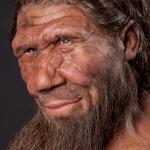Human Evolution Gallery (Natural History Museum)
On 18 December 2015, the Natural History Museum opened a new permanent gallery on human evolution. It features the known history of human, and close ancestor, evolution, from chimpanzees to Cheddar Man. Exhibits include replicaan exact copy of something.an exact copy of something., cast and actual skeletons from across the world and species, covering recently discovered Homo naledi hand, jaw and skull fossils, a Peking Man skull replica, AustralopithecineVery old ancestors of early human species. They have sometimes been called the missing link between apes and humans.Very old ancestors of early human species. They have sometimes been called the missing link between apes and humans. fossils, and NeanderthalAn extinct species (or subspecies) of human who lived in Eurasia between up to 600,000 years ago (the first 'true' Neanderthals being from around 250,000 years ago) and about 40,000 years ago. They lived alongside modern humans and interbred with them.An extinct species (or subspecies) of human who lived in Eurasia between up to 600,000 years ago (the first 'true' NeanderthalsAn extinct species (or subspecies) of human who lived in Eurasia between up to 600,000 years ago (the first 'true' Neanderthals being from around 250,000 years ago) and about 40,000 years ago. They lived alongside modern humans and interbred with them. being from around 250,000 years ago) and about 40,000 years ago. They lived alongside modern humans and interbred with them. and Homo sapiens bones. It describes the complex human family tree, the physical, social and environmental changes experienced by our ancestors, as well as new DNAHolds the genetic code to all living things, and is passed down to children from their parents.Holds the genetic code to all living things, and is passed down to children from their parents. research. It also displays the most scientifically accurate life-size Neanderthal and early Homo sapiens models ever made.
The Natural History Museum is always worthwhile day out, especially if you have children. Entry is free (although queuing is likely, and some temporary exhibitions charge) and the place is vast: the human evolution gallery is just one amongst a range of others, including the infamous dinosaur collections, and geologyThe science of studying the Earth and its past.The science of studying the Earth and its past., human biology, and contemporarySomeone or something living or occurring at the same time.Someone or something living or occurring at the same time. and extinct animal displays. Many of their galleries and collections are important, but none more so - to my mind - than their newest human evolution gallery. It doesn't just allow visitors to see skeletons which inform our understanding of the very nature of human existence, and which are usually inaccessible to the general public. It also gives visitors the opportunity to see many of the finds which describe early human habitation in the UK: not just bones, but tools, jewellery and the fossils of animals that shared their environment. It is even possible to touch a replica of the 900,000 year old footprint left in the Norfolk coastline and rediscovered in 2013. These are the oldest known footprints in Europe. There are hands-on displays and a film covering our current understanding of human DNA and migrationThe movement of people (or animals) from one place to another.The movement of people (or animals) from one place to another. (with a few celebrities helping out). However, it is the models that steal the show. Alongside basic ones showing the development of the human skull, the two life-size, exceptionally realistic models of Neanderthal and early modern man are breathtaking. It is possible to stand there and feel the gaze of these two separate species upon you. Not just the body shape, but their skin, hair and faces are a study in humanity over the past 100,000 years. If I wanted to be picky and find fault, I could mention the bias that makes the early modern man look threatening and is if he were hunting the friendly and approachable Neanderthal, but it is a small matter.
These are the oldest known footprints in Europe. There are hands-on displays and a film covering our current understanding of human DNA and migrationThe movement of people (or animals) from one place to another.The movement of people (or animals) from one place to another. (with a few celebrities helping out). However, it is the models that steal the show. Alongside basic ones showing the development of the human skull, the two life-size, exceptionally realistic models of Neanderthal and early modern man are breathtaking. It is possible to stand there and feel the gaze of these two separate species upon you. Not just the body shape, but their skin, hair and faces are a study in humanity over the past 100,000 years. If I wanted to be picky and find fault, I could mention the bias that makes the early modern man look threatening and is if he were hunting the friendly and approachable Neanderthal, but it is a small matter.
It is possible the human evolution gallery is not the most engaging gallery for young children. If children are delicate and, for example, scared of skeletons, then this is probably not the place to take them. Furthermore, if you find nudity offensive, then again perhaps this gallery should be avoided. The two main models are lifelike in every respect, and I must say I was pleased there was no hint of a fig leaf. But their 'dangly bits' were very much at my son's eye level! This aside, there is plenty to engage children. I've already mentioned the hands-on activities and the film, but the displays themselves are well-arranged and informative, with each one telling a different aspect of the human evolution story. The information is succinct yet it covers all the main points. There are also occasional talks throughout the day (although we sadly didn't catch any). This new gallery is very much in keeping with the general ethos of the Museum.
In conclusion, then, I can't recommend this new gallery enough. The Natural History Museum should always be on the 'to do' list for any trip to London, and the new human evolution gallery should be the first gallery to visit.
For more information on the Natural History Museum's human evolution gallery, click here.
- Log in to post comments







